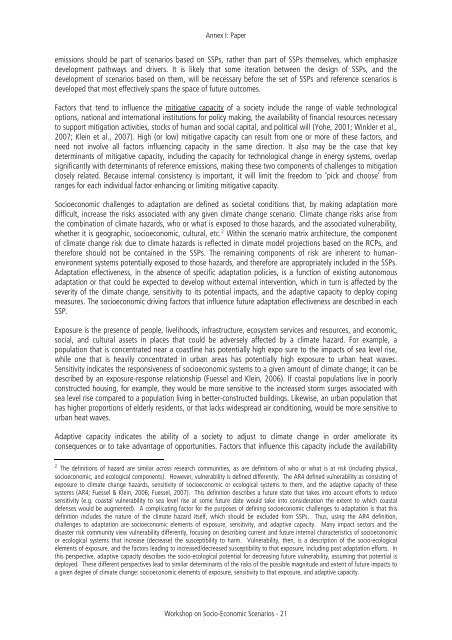Workshop Report - IPCC
Workshop Report - IPCC
Workshop Report - IPCC
You also want an ePaper? Increase the reach of your titles
YUMPU automatically turns print PDFs into web optimized ePapers that Google loves.
Annex I: Paper<br />
emissions should be part of scenarios based on SSPs, rather than part of SSPs themselves, which emphasize<br />
development pathways and drivers. It is likely that some iteration between the design of SSPs, and the<br />
development of scenarios based on them, will be necessary before the set of SSPs and reference scenarios is<br />
developed that most effectively spans the space of future outcomes.<br />
Factors that tend to influence the mitigative capacity of a society include the range of viable technological<br />
options, national and international institutions for policy making, the availability of financial resources necessary<br />
to support mitigation activities, stocks of human and social capital, and political will (Yohe, 2001; Winkler et al.,<br />
2007; Klein et al., 2007). High (or low) mitigative capacity can result from one or more of these factors, and<br />
need not involve all factors influencing capacity in the same direction. It also may be the case that key<br />
determinants of mitigative capacity, including the capacity for technological change in energy systems, overlap<br />
significantly with determinants of reference emissions, making these two components of challenges to mitigation<br />
closely related. Because internal consistency is important, it will limit the freedom to ‘pick and choose’ from<br />
ranges for each individual factor enhancing or limiting mitigative capacity.<br />
Socioeconomic challenges to adaptation are defined as societal conditions that, by making adaptation more<br />
difficult, increase the risks associated with any given climate change scenario. Climate change risks arise from<br />
the combination of climate hazards, who or what is exposed to those hazards, and the associated vulnerability,<br />
whether it is geographic, socioeconomic, cultural, etc. 2 Within the scenario matrix architecture, the component<br />
of climate change risk due to climate hazards is reflected in climate model projections based on the RCPs, and<br />
therefore should not be contained in the SSPs. The remaining components of risk are inherent to humanenvironment<br />
systems potentially exposed to those hazards, and therefore are appropriately included in the SSPs.<br />
Adaptation effectiveness, in the absence of specific adaptation policies, is a function of existing autonomous<br />
adaptation or that could be expected to develop without external intervention, which in turn is affected by the<br />
severity of the climate change, sensitivity to its potential impacts, and the adaptive capacity to deploy coping<br />
measures. The socioeconomic driving factors that influence future adaptation effectiveness are described in each<br />
SSP.<br />
Exposure is the presence of people, livelihoods, infrastructure, ecosystem services and resources, and economic,<br />
social, and cultural assets in places that could be adversely affected by a climate hazard. For example, a<br />
population that is concentrated near a coastline has potentially high expo sure to the impacts of sea level rise,<br />
while one that is heavily concentrated in urban areas has potentially high exposure to urban heat waves.<br />
Sensitivity indicates the responsiveness of socioeconomic systems to a given amount of climate change; it can be<br />
described by an exposure-response relationship (Fuessel and Klein, 2006). If coastal populations live in poorly<br />
constructed housing, for example, they would be more sensitive to the increased storm surges associated with<br />
sea level rise compared to a population living in better-constructed buildings. Likewise, an urban population that<br />
has higher proportions of elderly residents, or that lacks widespread air conditioning, would be more sensitive to<br />
urban heat waves.<br />
Adaptive capacity indicates the ability of a society to adjust to climate change in order ameliorate its<br />
consequences or to take advantage of opportunities. Factors that influence this capacity include the availability<br />
2<br />
The definitions of hazard are similar across research communities, as are definitions of who or what is at risk (including physical,<br />
socioeconomic, and ecological components). However, vulnerability is defined differently. The AR4 defined vulnerability as consisting of<br />
exposure to climate change hazards, sensitivity of socioeconomic or ecological systems to them, and the adaptive capacity of these<br />
systems (AR4; Fuessel & Klein, 2006; Fuessel, 2007). This definition describes a future state that takes into account efforts to reduce<br />
sensitivity (e.g. coastal vulnerability to sea level rise at some future date would take into consideration the extent to which coastal<br />
defenses would be augmented). A complicating factor for the purposes of defining socioeconomic challenges to adaptation is that this<br />
definition includes the nature of the climate hazard itself, which should be excluded from SSPs. Thus, using the AR4 definition,<br />
challenges to adaptation are socioeconomic elements of exposure, sensitivity, and adaptive capacity. Many impact sectors and the<br />
disaster risk community view vulnerability differently, focusing on describing current and future internal characteristics of socioeconomic<br />
or ecological systems that increase (decrease) the susceptibility to harm. Vulnerability, then, is a description of the socio-ecological<br />
elements of exposure, and the factors leading to increased/decreased susceptibility to that exposure, including past adaptation efforts. In<br />
this perspective, adaptive capacity describes the socio-ecological potential for decreasing future vulnerability, assuming that potential is<br />
deployed. These different perspectives lead to similar determinants of the risks of the possible magnitude and extent of future impacts to<br />
a given degree of climate change: socioeconomic elements of exposure, sensitivity to that exposure, and adaptive capacity.<br />
<strong>Workshop</strong> on Socio-Economic Scenarios - 21

















